Xylophanes ceratomioides
|
|
Updated as per
AN ANNOTATED CHECKLIST OF THE SPHINGIDAE OF BOLIVIA, October 2007
Updated as per http://www.pybio.org/SPHINGINAE.htm (Paraguay), October 2007
Updated as per More, Kitching and Cocucci's Hawkmoths of Argentina 2005, October, 2007
Updated as per personal communication with Johan van't Bosch (Mato
Grosso, Brazil, October 5), March 2008
Updated as per personal communication with Ezequiel Bustos (Aguas Blancas, Salta, Argentina, 405m); December 2009
Updated as per personal communication with Ezequiel Bustos (Shilap revta. lepid. 43 (172) diciembre, 2015, 615-631 eISSN 2340-4078 ISSN 0300-5267), January 4, 2016
Updated as per personal communication with Gernot Kunz (El Copan, Cartago, Costa Rica, March 6, 2019, 1047m); April 16, 2019
|
Xylophanes ceratomioides
zail-AH-fan-eesM sir-uh-toh-mee-OY-dehs or
zye-LAH-fan-eesM sir-uh-toh-mee-OY-dehs
(Grote & Robinson, 1867) Choerocampa
Brown and Yellow Sphinx
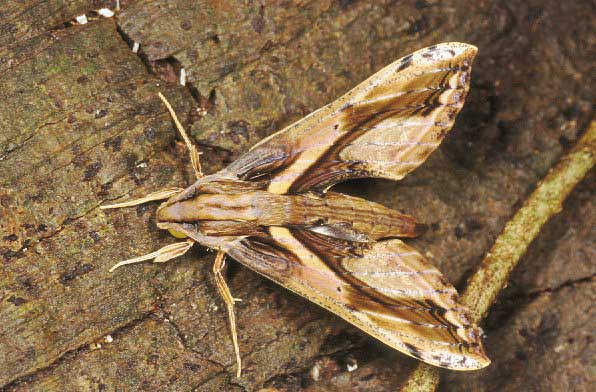
Xylophanes ceratomioides courtesy of Paolo Mazzei,
Rancho Grande, H. Pittier National Park, Venezuela.
This site has been created by Bill Oehlke.
Comments, suggestions and/or additional information are welcomed by Bill.
TAXONOMY:
Family: Sphingidae, Latreille, 1802
Subfamily: Macroglossinae, Harris, 1839
Tribe: Macroglossini, Harris, 1839
Genus: Xylophanes Hubner [1819] ...........
Species: ceratomioides (Grote & Robinson, 1867)
|
DISTRIBUTION:
The Brown and Yellow Sphinx Moth,
Xylophanes ceratomioides
[wingspan: 3 1/2 - 3 13/16 inches (70mm - 97mm)] flies in
Mexico;
Belize: Orange Walk, Cayo, Toledo;
Guatemala: Izabal (JM);
Costa Rica: Cartago: El Copan (GK);
French Guiana;
Colombia;
Ecuador;
Peru;
Bolivia: Santa Cruz: Ichilo, La Víbora;
La Paz: Sud Yungas, Yanacachi; Murillo, Zongo Chuchulluni;
Caupolican, Mamacona, Apolo; Cochabamba: Carrasco, Chapare;
Chapare, Yunga del Espíritu Santo;
Paraguay: San Pedro, Canindeyu,
Cordillera, Central, Guaira, Alto Parana (probably Caaguazu, Caazapa and
Itapua (WO??));
Argentina:
Jujuy, Misiones, Salta (405m EB);
and
Venezuela, down into
southern Brazil: Mato Grosso, Minas Gerais, probably Rio de Janeiro and Sao Paulo.
Mexico is the specimen type locality.
Those moths from northern Argentina, Paraguay and southeastern Brazil, previously thought to be ceratomioides, may be crenulata.
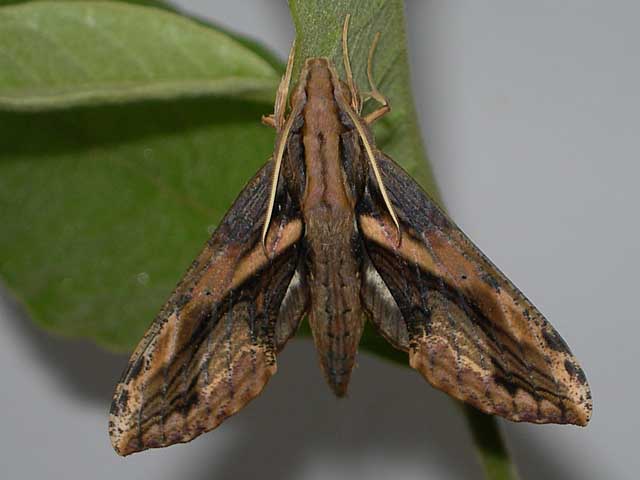
Xylophanes ceratomioides, Itanhandu, Minas Gerais, Brazil,
January 22, 2010, courtesy of Larry Valentine.
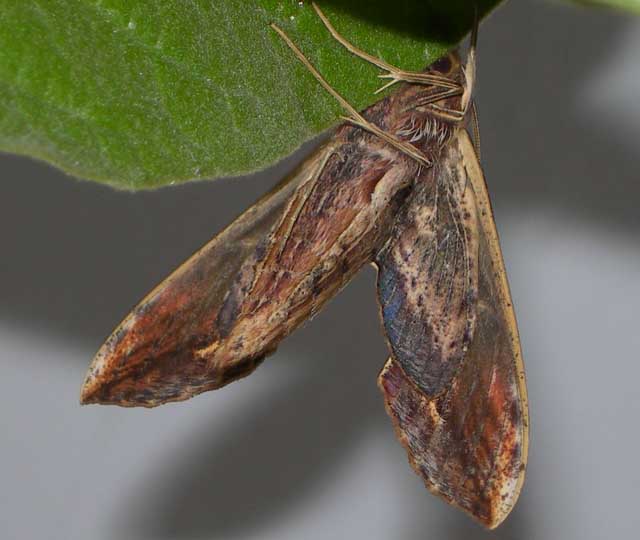
Xylophanes ceratomioides (verso), Itanhandu, Minas Gerais, Brazil,
January 22, 2010, courtesy of Larry Valentine.
"Outer margin of forewing slightly scalloped.
Long, narrow, whitish scales gives the upperside of the abdomen a striated appearance (present also in
Xylophanes colinae, Xylophanes guianensis, Xylophanes media and Xylophanes xylobotes). Abdomen dorsally with three narrow,
longitudinal lines; outer lines posteriorly divergent on each tergite and expanded into small triangular spots. Outer spur of midtibia shorter than inner.
Base of forewing upperside dark, often almost black but with an off-white patch on the inner edge (of the same colour as pale bands of hindwing upperside);
costa with several conspicuous subapical and apical black spots, the largest subapical spot triangular with inner point directed basally; most distal of antemedian
lines oblique, running along ventral edge of discal cell as far as CuA1; median area of the wing running out to the apex pale brown with scattered black
scales on the veins, discal spot small, black; oblique postmedian band dark with sinuate black lines within it, inner edge slightly undulate,
outer edge deeply excavate from CuA2 to just above M3, forming a pale brown, oval patch; marginal area with black vein spots.
"Subbasal band of hindwing upperside off-white, divided medially into two patches by a longitudinal black band; width of off-white median band variable
in width and length, sometimes connecting the costal margin and anal patch; sometimes not reaching Rs; the veins crossing it are sometimes all black." CATE
In the United States it is sometimes taken in southern Arizona.
The upperside of the forewing is yellowish brown with dark brown markings in the basal area, and diagonally from near the apex
to the center of the inner margin. There is a small dark cell spot.
The outer margin is distinct, set off from the rest of the wing by a pale subterminal line.
The upperside of the hindwing is dark brown with tan bands.
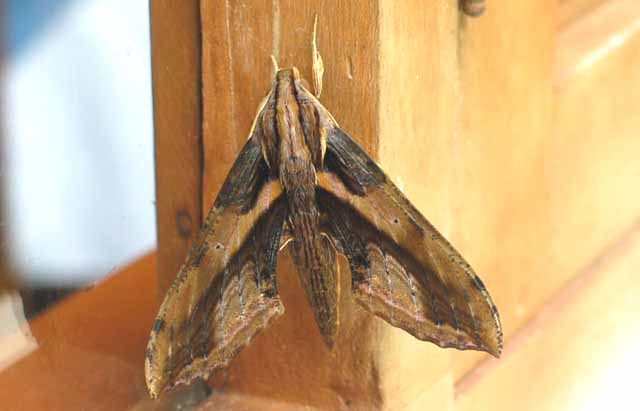
Xylophanes ceratomioides, Septimo Paraiso Lodge, Mindo,
Pichincha Province, Ecuador,
March 4, 2005; 4,200' elevation, courtesy of Robert Behrstock.
Choerocampa minas Menetries, 1857, French Guiana, is same as Xylophanes ceratomioides.
Anceryx capreolus Schaufuss, 1870, Venezuela, is same as Xylophanes ceratomioides.
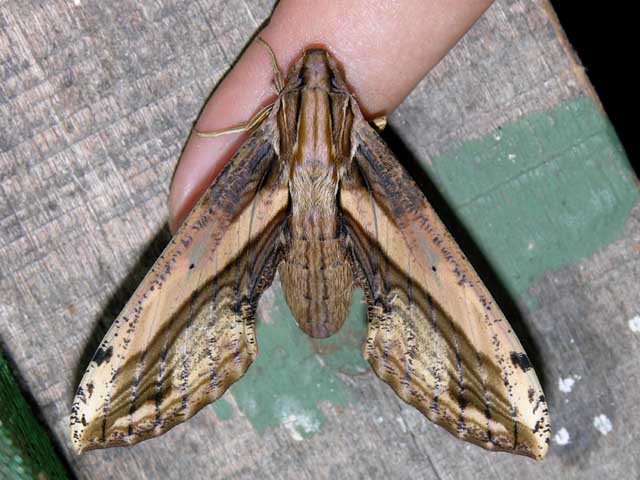
Xylophanes ceratomioides, Cristalino Jungle Lodge, Mato Grosso, Brazil,
October 5, 2007, 71m, courtesy/copyright of Johan van't Bosch.
FLIGHT TIMES:
Xylophanes ceratomioides has been recorded on the wing in every month in
Costa Rica. There are at least three broods in Peru:
January-February, June-July, and October. Larry Valentine reports a January flight in Itanhandu, southern Minas Gerais, Brazil.
Nigel Venters reports a February flight in Calilegua, Jujuy, Argentina.
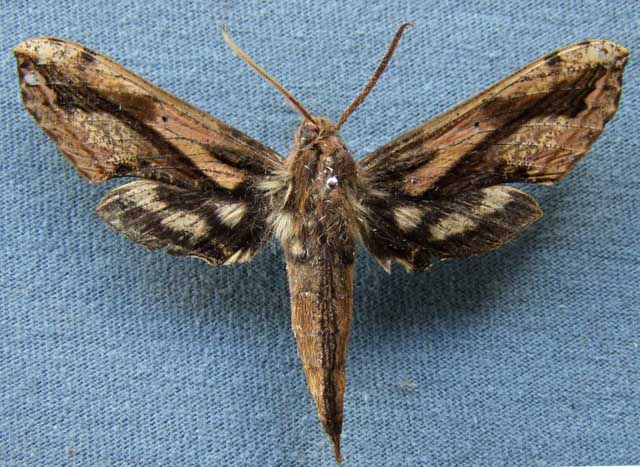
Xylophanes ceratomioides male, Calilegua, Jujuy, Argentina,
February 17, 2010, 1100m, courtesy of Nigel Venters.
ECLOSION:
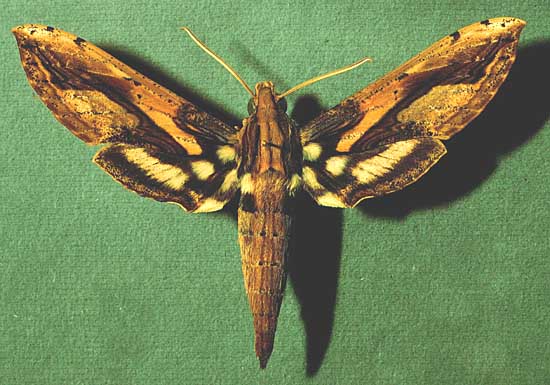
Xylophanes ceratomioides male courtesy of Dan Janzen.
SCENTING AND MATING:
Females call in the males with a pheromone released from a gland at the tip of
the abdomen. The females do come in to lights but not nearly as often as the males.
EGGS, LARVAE, PUPAE:
Larvae feed on Psychotria berteriana, Psychotria correae,
Psychotria microdon and Hamelia patens in the Rubiaceae family.
The caterpillar is very dark, has a
small cream eye on each side and a lighter gray-brown patch around each spiracle. There is also a green colour morph.
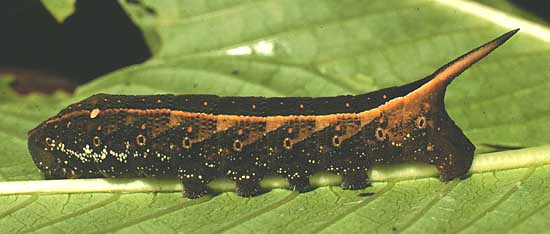
Moths emerge from pupae in 17-35 days. Larva and pupa images courtesy of Dan Janzen.
| 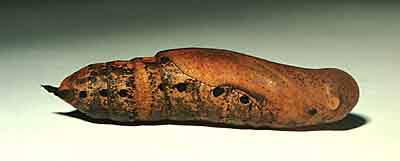 |
Larvae are subject to parasitization by Meteorus congregatus of the Braconidae family.
Visit Xylophanes ceratomioides adult, larva and pupa, Itanhandu, Minas Gerais, Brazil,
courtesy of Larry Valentine.
The pronunciation of scientific names is troublesome for many. The "suggestion" at the top of the page is merely a suggestion. It is based on
commonly accepted English pronunciation of Greek names and/or some fairly well accepted "rules" for latinized scientific names.
The suggested pronunciations, on this page and on other pages, are primarily put forward to assist those who hear with internal ears as they read.
There are many collectors from different countries whose intonations and accents would be different.
Jean Marie Cadiou writes, "When I say "Xylophanes" in English I pronounce it something like "Zailophanees", with the emphasis on the
"o". The French pronounce it differently, something like "Kzeelophaness" with no emphasis, and the Germans yet in a different way..."
In Greek myth, Phanes is the golden winged Primordial Being who was hatched from the shining Cosmic Egg that was the source of the
universe. He personifies light emerging from chaos.
"Xylo" is the Greek word for wood.
The specimen type for the genus Xylophanes is Xylophanes anubus. Perhaps ? when Hubner
examined this species, the yellow-orange and brown tones of the forewings suggested wings of wood.
The origin of the species name "ceratomioides" is unknown to me, but in the Greek "cerato"
and "cera" both refer to horn. I think there is also the possibility there may be a connection to golden or yellow.
Use your browser "Back" button to return to the previous page.
Goto Main Sphingidae Index
Goto Macroglossini Tribe
Goto Central American Indices
Goto Carribean Islands
Goto South American Indices
Goto U.S.A. tables
Visit Xylophanes ceratomioides additional images.








